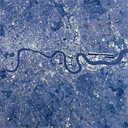
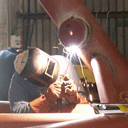
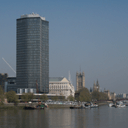
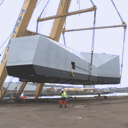
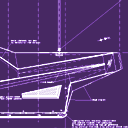
Design
Click on photos for enlargements.
Page 1 - Engineering
Millbank Pier is the fifth and last of the Central London passenger piers to be built with funding assistance from the Millennium Commission. The pier enables a riverbus service to link Tate Britain gallery to the London Eye and Saatchi gallery at Waterloo Pier and Tate Modern gallery at Bankside Pier. The boat serving this route is in a livery designed by Damien Hirst. Since it is the upstream pier on this art lovers' route Millbank Pier's appearance is a major design consideration.
Traditionally the appearance of Thames piers has been dominated by the dolphins which hold the pontoon in position. More recently designs have used large monopiles but the visual impact, particularly at low tide, of either dolphins or monopiles can be overwhelming. The effect is worse on a single berth pier where the pontoon size is small in relation to the dolphin or monopile height.
There are two possible alternatives to dolphins for securing the pontoon. One option is to secure the pontoon is a recess built into the river wall. This was the solution used for the original piers on the Thames when the Victoria Embankment was constructed. Of five original inset piers only one remains in its original state. This is the Police pier outside Somerset House.
To build a new inset pier would be prohibitively expensive unless it was done at the same time as reconstruction of the river wall, so this was not an option for Millbank.
The other alternative to dolphins is to secure the pontoon on radial arms. Radial arms are well established for securing piers with the most well known example being on Liverpool Landing Stage. On the Thames Gravesend's West Street Pier is secured laterally on a pair of radial arms and longitudinally by ground chains connected to anchors.
Radial arms are conventionally located entirely above water level with a landward fixing either to the shore or to a dolphin structure above MHWS. While there are many advantages of a shore fixing the arrangement is rarely possible in Central London without major work to the Embankment wall. So, as an alternative at Millbank we used shorter radial arms secured at their inner ends to stub piles with the pile-radial arm bearing connection at mid-tide level. This detail provides a minimum visual impact.
To place the bearing at mid-tide requires careful selection of the bearing materials. Millbank Pier uses rubber bearings which operate as well dry as they do submerged. They are also immune to ingress by silt and grit and are virtually maintenance free.
Prior to using this system at Millbank we trialed it on a temporary muck away jetty built for the Jubilee line extension works at Jubilee Gardens in 1995.
This jetty was in place for 3 years. When dismantled parts of the muck away jetty, including the radial arms, were reused on Savoy Pier which is also a temporary structure although it has now been in service for over five years.
Both Jubilee Gardens jetty and Savoy Pier use cables connected to anchors laid beneath the pontoon to hold the pier in position longitudinally. This is a cost effective solution for a temporary structure but in the longer term it leads to maintenance difficulties. Consequently it was not considered an appropriate solution for a permanent pier such as Millbank. At Millbank the pontoon is held longitudinally by the brow which is at an angle of 35 degrees to the pontoon's centreline and works as a third radial arm.
The Millbank brow at 60m is the second longest passenger pier brow on the Thames. Only the 84m brow at the Dome pier is longer. This length of the brow is necessary principally to maintain gradients below 1 in 12 for disabled access. Even so to achieve 1 in 12 with a 6 metre tidal range required a deck ramp on the pontoon as well as a long brow. To integrate the deck ramp into the pier aesthetically was a major challenge for the design team.
Supporting a large brow on a small, and therefore lively, pontoon, requires careful design of the brow's bearings. This is particularly so when the brow also serves as a radial arm. At Millbank the brow is supported upon three bearings. At the bankseat are two conventional pinned bearings supported on a swivel beam. At its outer end the brow is connected to the pontoon by a single central spherical bearing. This arrangement allows the pontoon to roll and pitch without transferring any torsional loading to the brow.
Tim Beckett
Pontoon Length Overall - 39.5m
Length of Berthing Face - 30m
Pontoon width - maximum - 13.4m
Weight of Pontoon without ballast - 230 tonnes
Weight of ballast - pig iron - 75 tonnes
Brow length between bearings - 60.28m
Brow width - 3.9m
Brow height - 3.5m
Brow weight - 88 tonnes
Radial arm length - 15m
Tidal range - springs - 6.2m